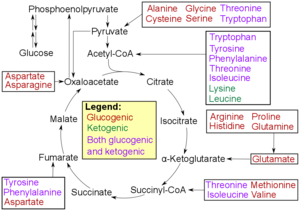
Back Aminoàcids cetogènics Catalan Ketogenní aminokyseliny Czech آمینواسید کتوژنیک Persian Ketogeeninen aminohappo Finnish Acide aminé cétoformateur French Aminoácido cetoxénico Galician Amminoacidi chetogenici Italian ケト原性アミノ酸 Japanese 케톤체생성성 아미노산 Korean Aminokwas ketogenny Polish

A ketogenic amino acid is an amino acid that can be degraded directly into acetyl-CoA, which is the precursor of ketone bodies and myelin, particularly during early childhood, when the developing brain requires high rates of myelin synthesis.[1] This is in contrast to the glucogenic amino acids, which are converted into glucose. Ketogenic amino acids are unable to be converted to glucose as both carbon atoms in the ketone body are ultimately degraded to carbon dioxide in the citric acid cycle.
In humans, two amino acids – leucine and lysine – are exclusively ketogenic. Five more are amphibolic (both ketogenic and glucogenic): phenylalanine, isoleucine, threonine, tryptophan and tyrosine. The remaining thirteen are exclusively glucogenic.[2]
- ^ Yudkoff, Marc; Daikhin, Yevgeny; Melø, Torun Margareta; Nissim, Ilana; Sonnewald, Ursula; Nissim, Itzhak (2007). "The Ketogenic Diet and Brain Metabolism of Amino Acids: Relationship to the Anticonvulsant Effect". Annual Review of Nutrition. 27: 415–30. doi:10.1146/annurev.nutr.27.061406.093722. ISSN 0199-9885. PMC 4237068. PMID 17444813.
- ^ Berg J, Tymoczko J, Stryer L (2015-04-08). "Protein Turnover and Amino Acid Catabolism". Biochemistry (8th ed.). Macmillan Learning. ISBN 978-1-4641-2610-9. Archived from the original on 2007-06-30.